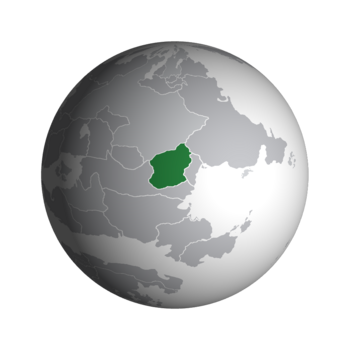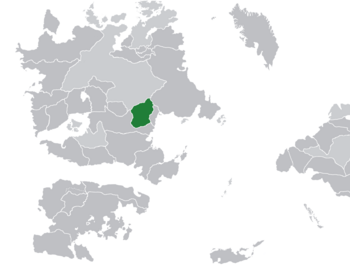Montesayette
Montesayettean Commonwealth Communauté montesayette | |
|---|---|
Motto: Ensemble vers un lendemain meilleur "Together towards a better tomorrow" | |
Location of Montesayette (dark green) | |
| Capital and largest city | Nerfoy |
| Official languages | |
| Recognised regional languages | |
| Ethnic groups (2022) |
|
| Religion (2022) |
|
| Demonym(s) | Montesayettean |
| Government | Federal presidential constitutional republic |
| Hervé Dufriche-Desgenettes | |
| Marielle Bettencourt | |
| Jean-Baptiste Brisbois | |
| Corbin Perreault | |
| Olivie Fabron | |
| Legislature | National Assembly |
| Senate | |
| House of Representatives | |
| Area | |
• Total | 1,743,230 km2 (673,060 sq mi) |
| Population | |
• 2017 census | |
• Density | 39.53/km2 (102.4/sq mi) |
| GDP (nominal) | 2022 estimate |
• Total | |
• Per capita | |
| Gini (2022) | low |
| HDI (2022) | high |
| Currency | Montesayettean pound (MSP) |
| Time zone | AMT-1 |
| Date format | dd-mm-yyyy (CE) |
| Mains electricity | 230 V–50 Hz |
| Driving side | right |
| Calling code | +37 |
| ISO 3166 code | SY |
| Internet TLD | .sy |
Montesayette (Quebecshirite: ![]() /mɔ̃.tɛ.sɛt/), officially the Montesayettean Commonwealth (Quebecshirite: Communauté montesayette /kɔmy.nɔ.te mɔ̃.te.sɛt/), is a landlocked country located in Ecros. It shares borders with Terranihil to the south and west, Majocco to the north, and Quebecshire and Eleutherios to the east. The country is nominally a federation of nine provinces and one autonomous city, which is the capital and largest city of the country, Nerfoy, but in practice both its government and its economy are highly centralized. It has an estimated population of 65.15 million according to the 2017 census, of which roughly one-third live in the Greater Nerfoy Area, which includes Audrecelles and Hamicourt alongside the capital itself. Other major cities include Lavignole, Chenonceaux and Brumeville.
/mɔ̃.tɛ.sɛt/), officially the Montesayettean Commonwealth (Quebecshirite: Communauté montesayette /kɔmy.nɔ.te mɔ̃.te.sɛt/), is a landlocked country located in Ecros. It shares borders with Terranihil to the south and west, Majocco to the north, and Quebecshire and Eleutherios to the east. The country is nominally a federation of nine provinces and one autonomous city, which is the capital and largest city of the country, Nerfoy, but in practice both its government and its economy are highly centralized. It has an estimated population of 65.15 million according to the 2017 census, of which roughly one-third live in the Greater Nerfoy Area, which includes Audrecelles and Hamicourt alongside the capital itself. Other major cities include Lavignole, Chenonceaux and Brumeville.
Under the 1991 constitution, Montesayette is a federal presidential constitutional republic with a bicameral legislature, the National Assembly. The country's head of state and head of government is the president, who is directly elected to a seven-year term, with no constitutional term limits in place. While the country is a multi-party democracy with free elections, the government under the Social Democratic Party (PSD) wields significant control and dominance over politics and society. The PSD has remained in power continuously since 1921, currently holding TBA out of TBA seats in the National Assembly following the 2023 Senate election. Montesayette is considered a middle power. It is a member of the Terraconserva Council of Nations, the Alliance of Central Ecrosian States, and the Eastern Ecros Free Trade Area.
Contents
History
Geography
Climate
Biodiversity
Government and politics
Montesayette is a federal presidential constitutional republic as outlined by the Constitution of the Montesayettean Commonwealth. According to L'Étoile Nerfoy, the Montesayettean Commonwealth is "a dominant-party state with the sheen of a progressive, modern state," ruled by the Social Democratic Party continuously since the end of the preceding socialist republic in 1921. Although Montesayette is nominally an "inclusive, socialism-oriented, democratic and secular federation that adheres to multi-party democracy," it has in practice maintained a system of guided democracy and highly centralized government since 1972, when the nation voted to end its decade-long period of federal parliamentary democracy. The current constitution, sometimes referred to as the Fifth Montesayettean Commonwealth, was adopted in 1991 with the aim to, according to the Dufour administration, "liberalize the nation while maintaining a strict regime of check and balance to avoid the mistakes of the Third Commonwealth," following a constituent assembly earlier the same year.
The Montesayettean national government is separated into three branches: executive, legislature and judiciary. The country's head of state, head of government and head of the Montesayettean Defense Forces in wartime is the president of Montesayette, who is directly elected to a seven-year term, with no constitutional term limits in place. The president can propose legislation to the National Assembly, declare a state of emergency or martial law, subject to the National Assembly's subsequent approval. The president also has veto power, subject to a two-thirds majority override by the National Assembly. However, the president does not have the power to dissolve the National Assembly. The president is also assisted in his or her duties by the Prime Minister of Montesayette, the Chief Cabinet Secretary, and his or her ministers, all of whom collectively form the State Council of Montesayette. The prime minister is the principal executive assistant to the president, with the president being the actual head of government, but not the prime minister.



